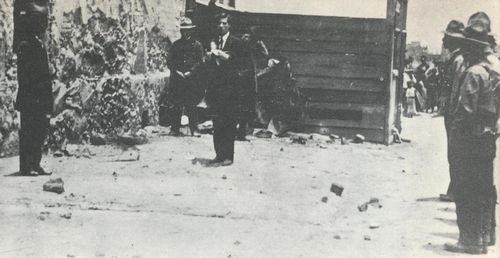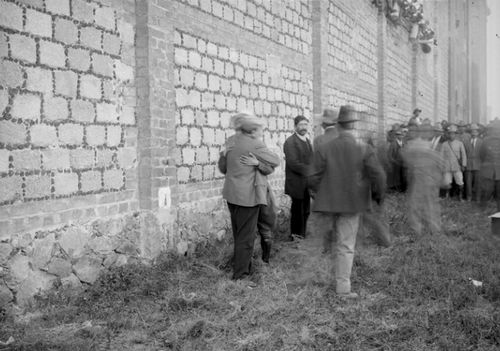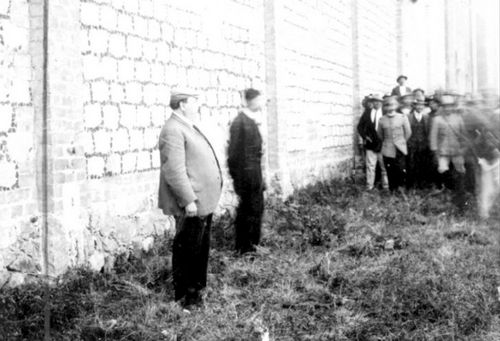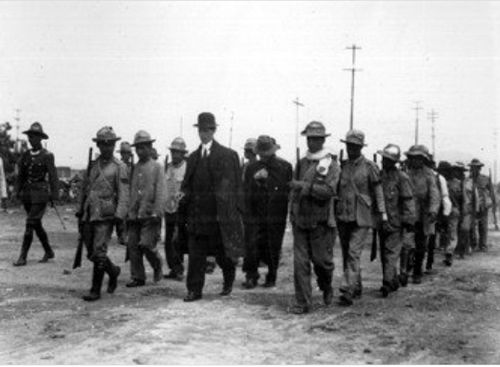Counterfeit cartones
The cartones were widely counterfeited. However, newspaper reports rarely given any indication of the nature of the counterfeiting, apart from commenting that they ranged from poor to excellent imitation, and given the cartones’ size and deterioration through constant use, it is not surprising that the ordinary person would be hard-pressed to recognise a counterfeit. A taxonomy of counterfeit cartones would defeat even me, but perhaps someone who collects these pieces or lives in Mexico could hazard an attempt.
Reports
As well as instances in San Juan del Río, Querétaro these are contemporaneous reports of the counterfeiting of cartones.
Mario Rolla
0n 28 October 1914 an Italian, Mario Rolla, was apprehended by the police as he was trying to pass a large quantity of counterfeit 5c and 20c cartones in a store in the city centre. He was found to have a seal with the national shield which he used to stamp his cartonesNueva Patria, Tomo I, Núm. 34, 29 October 1914.
Galo M. Larín, José Cuesta, Heriberto González and M. Sevilla
On 2 January 1915 a workshop for producing counterfeit cartones was discovered in Colonia Vallejo. As well as equipment the police found two boxes of bogus 10c and 20c cartones and four individuals named Galo M. Larín, José Cuesta, Heriberto González and M. SevillaLa Opinión, Año I, Tomo I, Núm. 29, 3 January 1915. The criminals had already circulated several thousand pesos in false cartonesLa Opinión, Año I, Tomo I, Núm. 30, 4 January 1915 with an image.
Emiliano Ochoa
On 5 April Emiliano Ochoa, who lived at 3a. calle del Peñón 38, was arrested for counterfeiting 20c cartones. The police discovered various implements, cameras, cliches, special paper and $50 in counterfeit cartonesThe Mexican Herald, Año XX, No. 7151, 6 April 1915.
José Navarro, Antonio Gómez and Alvaro Camargo
On 7 April José Navarro, Antonio Gómez and Alvaro Camargo were shot for counterfeiting 20c cartones. Navarro was the ringleader and funded the operation, Gómez owned the printshop and Camargo was the engraver. They had issued $5,000 a day in the four day before they were arrested. Around twenty people had been arrested for counterfeiting cartonesThe Mexican Herald, Año XX, No. 7152, 7 April 1915.
Humberto Taglelaubet, Lorenzo Aguilar, Rafael Dávalos, María Constanza and Matildo Medina
These were arrested on 28 May 1915 for counterfeiting 20c cartones. The experts at the Oficina Impresora de Estampillas admitted that they were very well madeEl Norte, 5 June 1915. However, another report was less complementary. It said that the cartones were badly counterfeited (burdamente falsificados) and were missing the seal. The cliches were made of copper, but so badly done that it was almost impossible to distinguish the main features and the cartones were printed by placing the cliches on the cardboard and then a heavy weight, so some impressions were blurred (El Renovador, 5 July 1915).
J. Guadalupe Martínez and Ernesto Escárcega
On 30 May 1915 J. Guadalupe Martínez and Ernesto Escárcega were aprehended by teniente Elodio González while circulating counterfeit 20c cartones in various markets. Under interrogation the two blamed one another and also implicated others in the crime. They were to be transferred by the Comandancia Militar to a military tribunal for punishmentEl Norte, Tomo I, Núm 34, 31 May 1915.
Teófilo and Silvestre Durán, Carlos Quesada, Adolfo Rosas, Felipe Retana, Ernesta Cervantes and Damiana Estrada
On 28 June the police discovered a ‘factory’ in 12a. calle de Mazatlán, in colonia Vallejo and arrested Teófilo and Silvestre Durán, Carlos Quesada, Adolfo Rosas, Felipe Retana, Ernesta Cervantes and Damiana Estrada, as they were producing more than 500 20c cartones, lacking only the final overstamp. They found two lead cliches of the face and reverse. The police than went to a ‘branch’ at 1a calle de Régules 10, where they found more instruments and a good quantity of half-printed cartonesEl Combate, Tomo I, Núm. 12, 28 June 1915.
Juan M. Ríos
The police discovered another ‘factory’ making $50 sábanas and 10c and 20c cartones at calle de Altamirano 792, Tacubaya, the home of Juan M. Ríos. Pedro Mata was arrested as an accompliceThe Mexican Herald, 29 June 1915.
0n 19 July five people were arrested for at casa C on the corner of calles del Dr. Pascua y Andrade for counterfeiting 10c and 20c cartones. All the usual paraphernalia was recoveredThe Mexican Herald, 19 July 1915.
On 30 July 1915 El Renovador printed an editorial decrying the recent decree[text needed] of the governor of the Distrito Federal, Gildardo Magaña, that ordered the free circulation of cartones as people were refusing to accept them because of the number of poor counterfeits in circulation and knew that sooner or later the cartones would be disownedEl Renovador, Tomo I, Núm. 36, 30 July 1915.
Adrián Mirón, Francisco Bocardo, Margarito Meléndez, Reyes Noria, Ramón Vargas, Lucio Castillo, Miguel Arellano, Isabel Osorno, Pilar Hernández and Micaela Gutiérrez
On 17 August 1915 the police discovered a ‘factory’ producing 10c cartones in calle de Santana 50, Guadalupe, Hidalgo. They arrested seven men and three women (Adrián Mirón and his wife Isabel Osorno, who owned the house, Francisco Bocardo, Margarito Meléndez, Reyes Noria, Ramón Vargas, Lucio Castillo, Miguel Arellano, Pilar Hernández and Micaela Gutiérrez) and removed a printing press, a good number of clichés and plates, brushes, ink, and a large quantity of pressboards already cut and ready for printing. After investigation the prisoners would be consigned to the Cuartel General del Cuerpo de Ejército de OrienteThe Mexican Herald, Año XX, No. 7272, 18 August 1915.
Rafael M. Meza
On 4 August the police found a ‘factory’ for 10c cartones in 9a calle del Factor. These were recognizable as they were printed on a dull blue (azul opaco) pressboardThe Mexican Herald, 6 August 1915. The counterfeiter, Rafael M. Meza, who had been unwittingly betrayed by his own son, was shot a couple of weeks laterThe Mexican Herald, Año XX, No. 7272, 18 August 1915.
On 6 August notices were put up on the trams that the inspectors of the Compañía de Tranvías Eléctricos were authorised by the military authorities to cancel any counterfeit cartones that they were offeredThe Mexican Herald, Año XX, No. 7263, 9 August 1915.
Carlos Meza
 Carlos Meza was discovered by police with his wife in the act of counterfeiting 10c cartones. He was judged by the Consejo de Guerra and publicly executed in front of the Tercera Delegación de Policía on 19 August 1915. General Pablo González pardoned the wife and gave her money for her two childrenGeneral Francisco L. Urquizo, Recuerdo que …. Though this person shared a surname with the previous record they appear to have been different cases. Rafael Meza was shot on 18 August in the former polígono of Peralvillo, near to the Hipódromo of the same name.
Carlos Meza was discovered by police with his wife in the act of counterfeiting 10c cartones. He was judged by the Consejo de Guerra and publicly executed in front of the Tercera Delegación de Policía on 19 August 1915. General Pablo González pardoned the wife and gave her money for her two childrenGeneral Francisco L. Urquizo, Recuerdo que …. Though this person shared a surname with the previous record they appear to have been different cases. Rafael Meza was shot on 18 August in the former polígono of Peralvillo, near to the Hipódromo of the same name.
Francisco San Román, Manuel Arnulfo Morado, Julio Morado, Galo Mier Lamadrid, Macario Suárez and Miguel Badillo
 On 1 October 1915 Francisco San Román, Manuel Arnulfo Morado, Julio Morado, Galo Mier LamadridWas this the same person as the Galo M. Larín mentioned earlier, Macario Suárez and Miguel Badillo were shot in the Escuela de Tiro for counterfeiting cartones.
On 1 October 1915 Francisco San Román, Manuel Arnulfo Morado, Julio Morado, Galo Mier LamadridWas this the same person as the Galo M. Larín mentioned earlier, Macario Suárez and Miguel Badillo were shot in the Escuela de Tiro for counterfeiting cartones.
Manuel Wang, Felisa Guerrero, Magdalena Guerrero and Fernando Ortiz
On 6 October the police discovered a group making counterfeit cartones at a house at 167, 7a calle de Mesones, and arrested two Chinese, two Mexicans, two women and a girl. The Chinese were Manuel Wang and [ ], the Mexicans Wang’s brother-in-law and a Fernando Ortiz, and the others Wang’s wife, Felisa Guerrero, her mother, Magdalena Guerrero, and her adopted daughter, Florentina Hernández. Fernando Ortiz leapt off a balcony at police headquarters to escape but was caught by another policeman.
The police found numerous utensils such as seals, numbering stamps (foliadores), inkers, rubber type, clichés and pieces of cardboard ready to be printed. All the instruments collected struck the investigators as of a coarse nature. The cartones that were going to be printed were dirty yellow, and the counterfeiters obviously had little ingenuity to commit their crime, because they used up to five and six clichés to print a single cartón, some of rubber, those of the black marginal lines, others of zinc, those of the eagle and the figure of justice (so these were 20c cartones), and others of wood. The letters were also printed with rubber stamps. Serial numbers are squat (achaparrados) and printed with violet inkThe Mexican Herald, 7 October 1915.
Salustio Bárcenas, Leopoldo Cardona, Francisco Espinosa, and Adelaido Velázquez
 Adelaido Velázquez was a 52-year-old lawyer, living at 3a calle de la Violeta no. 63; Leopoldo Cardona, a 33-year-old businessman, living at 4a calle de Lerdo no. 124; Salustio Bárcenas, a 32-year-old printer, living at callejón de Niño Perdido no. 24; and Francisco Espinosa, a 24-year-old deaf-mute litographer, from Zamora, Michoacán, living at 2a calle de Cocheras no. 70. These were arrested by the Policía Especial de la Comandancia Militar, along with their equipment and false currency (cartones and sábanas), and confessed their crime. They had been involved in a plant for bottling wine and so acquired the press and other lithographic equipment needed to print labels, but from mid-1913 had found it more productive to produce cartones and notes.
Adelaido Velázquez was a 52-year-old lawyer, living at 3a calle de la Violeta no. 63; Leopoldo Cardona, a 33-year-old businessman, living at 4a calle de Lerdo no. 124; Salustio Bárcenas, a 32-year-old printer, living at callejón de Niño Perdido no. 24; and Francisco Espinosa, a 24-year-old deaf-mute litographer, from Zamora, Michoacán, living at 2a calle de Cocheras no. 70. These were arrested by the Policía Especial de la Comandancia Militar, along with their equipment and false currency (cartones and sábanas), and confessed their crime. They had been involved in a plant for bottling wine and so acquired the press and other lithographic equipment needed to print labels, but from mid-1913 had found it more productive to produce cartones and notes.
Velázquez, Cardona and Bárcenas were sentenced to death: Espinosa to ten years imprisonment. Bárcenas and Velázquez were shot in the Escuela de Tiro on the morning of 13 November.


Cardona escaped from his prison in the main gate of the Palacio Nacional, whilst under the watch of teniente Felipe Acevedo. Acevedo and cabo José Aguilar were shot for allowing him to escapeEl Pueblo, 13 November 1915.

Teniente Acevedo and Cabo Aguilar shot for allowing Cardona to escape
The cartones were the old 5c, 10c and 20c Gobierno Provisional de MéxicoEl Demócrata, Guadalajara,12 November 1915.
A ‘factory’ for counterfeit cartones was discovered in Toluca on 21 November 1915El Demócrata, Guadalajara, Tomo I, Núm, 22, 22 November 1915.
Manuel González Montenegro, José Santos Gómez, and José G. Gallegos

Manuel González Montenegro, José Santos Gómez, and José G. Gallegos were shot on 10 December 1915 for counterfeiting Constitutionalist money. Santos Gómez was a printer and, with various others, was caught by the Comisario of the Policía Judicial Militar, coronel Fernando L. Echegaray, while counterfeiting 10c cartones in a house in the Calle del Topacio. The pólice recovered a “Eugenio Brisset” lithographic press with all its accesories, various sheets of complete cartones and other blank sheets, inks, tools and two clichesEl Democrata, Tomo II, Núm. 374, 10 December 1915. They were condemned to death by Pablo González and shot in the Escuela del Tiro.
